Primary Data Types themselves could be of several types. For example, a char could be an unsigned char or a signed char. Or an int could be a short int or long int. Due these variations in the primitive data types, its very difficult to understand the concept. So let us take a closer look at these variations of primary data types in the tutorial:
=> Integers , long and short:
- The range of an integer constant depends upon the compiler.
- For a 16 bit Compiler like Turbo C or Turbo C++ the range is -32768 to 32767.
- For a 32 bit compiler like Visual Studio or gcc the range would be -2147483648 to 2147483647.
- C offers a variation of the Integer data type i.e short and long integer values.
- The intention of providing these variations is to provide Integers with different ranges whenever possible.
Each compiler can decide appropriate sizes of int , long and short depending on the operating system and hardware, for which it is being written, subject to following Rules:
- shorts are atleast 2 bytes big.
- longs are atleast 4 bytes big.
- shorts are never bigger than ints.
- ints are never bigger than longs.
| Compiler | short | int | long |
| 16-bit (Turbo C/C++) | 2 | 2 | 4 |
| 32-bit (Visual Studio ) | 2 | 4 | 4 |
=> long Variables:
- long variables which hold long Integers are declared using the keyword long.
Example:
long int a;
long int xyz;
- long integers causes the Program to run a bit slower, but the Range of values that we can use is Expanded tremendously.
- The value of long Integer typically can vary from -2147483648 to 2147483647.
=> short Variables:
- short variables which hold short integers are declared using keyword short as shown
Example:
short int b;
short int cool;
- short needs Less space in Memory and thus helps in speed of Program Execution.
NOTE: C allows to write short int to short and of long int to long. So declaration made very easy.
Example:
long a;
long xyz;
short b;
short cool ;
NOTE: Sometimes we come across situations where the constant is small enough to be an int , but still we want to give it as much storage as a long. In such cases , we add the suffix 'L' or '1' at the end of the number i.e 23L
That's All










0 Response to "Difference Between an Integer , short and long Variables"
Post a Comment